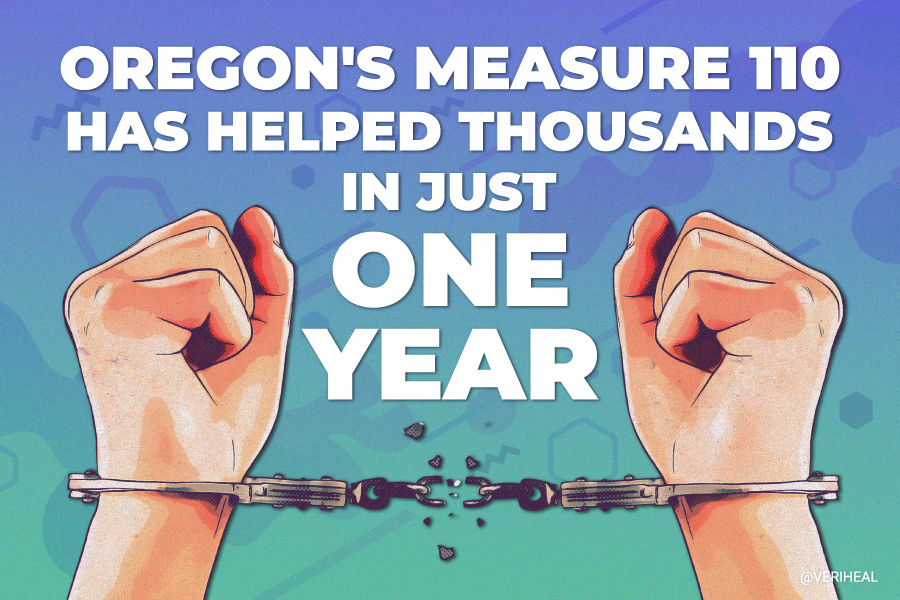Not only was Oregon one of the first states to legalize cannabis for medical and recreational use, but it was also the first to boldly contest the war on drugs. In November 2020, Measure 110 (Drug Decriminalization and Addiction Treatment Initiative) passed by majority vote in Oregon, bringing forth a new era in combating drug addiction and prioritizing criminal justice reform in the state.
The measure went into effect in early 2021. A year later, the results are promising! Filter reports that one year after going into effect, Measure 110 has boosted harm reduction and housing.
What Is Measure 110?
Measure 110 officially decriminalized the minor personal possession of all drugs in the state of Oregon. It did not decriminalize selling or manufacturing drugs, only simple possession for personal consumption. Minor drug possession convictions were reclassified as civil violations. Those caught with a small amount of drugs in their possession now face up to a $100 fine and no jail time.
Furthermore, any fines can be avoided by participating in a health assessment. The measure also included provisions that will allow for the creation of roughly 12 treatment centers that will provide 24/7 access to healthcare services for those dealing with drug addiction. This measure also changed Oregon’s system for cannabis tax revenue distribution. At the time of Measure 110’s passing, taxes were allocated as follows:
- 20% to local governments
- 15% to Oregon State Police
- 5% to Oregon Health Authority
- 20% to Oregon mental health, alcoholism, and drug services
At the time of passing, it was predicted that this measure would help to reduce drug possession convictions by as much as 90%. Predictions estimated that by not prosecuting drug convictions between 2021 and 2023 alone, Oregon could save roughly $24.5 million! With that in mind, let’s dive into some of the results of the measure one-year post-implementation.
According to information from the Drug Policy Alliance shared by Filter, there were 60% fewer drug arrests in the state of Oregon in the 10 months following Feb. 1, 2021, in comparison to the same period of time in the previous year. The number of low-level drug convictions reduced drastically. In the same 10-month time period of the previous year, there were 9,100 arrests. A 60% reduction means that roughly 5,500 fewer people were arrested for drug offenses in Oregon thanks to Measure 110.
The Expansion of Harm Reduction Services
The measure also required that a portion of cannabis tax revenue be held in a special fund that would allow the expansion of services to individuals that utilize various drugs. According to Marijuana Moment, prior to the passing of Measure 110, Oregon ranked “near the bottom of all U.S. states for access to substance use disorder (SUD) treatment.”
Thanks to Measure 110’s passing and implementation, though, over $31.4 million has been paid to harm reduction, peer support, housing, and employment support providers. Experts estimate that over 16,000 Oregon residents have benefitted from services funded by Measure 110:
- 59% received harm reduction services such as safe sex supplies, sterile syringes, & naloxone
- 15% received housing assistance
- 11% received peer services
- 11% received clinical screenings
Starting in mid-February, the state is estimated to pay out an additional $302 million. This money will be utilized to address the many funding requests received from providers across the state in order to create a behavioral health resource network spanning every county. Having a one-stop system that allows county service providers across the state to coordinate will make it much easier for people to get the care they need.
Monta Knudson, CEO of Oregon treatment and housing provider Bridges to Change, stated the following regarding this new resource network:
“A person could call one of the numbers, they could get hold of a ‘[service] navigator. That navigator could send a peer recovery mentor to pick them up, to get them to an assessment site and figure out what it is they’re asking for and what they need, and they do all the background work.”
It is estimated that less than 1% of those who accessed substance use disorder (SUD) treatment in the state did so through funding from Measure 110. However, Measure 110 was written to provide much more than just SUD treatment resources. Funding from Measure 110 has picked up the bill for things such as residential and outpatient programs, in addition to medications such as methadone and buprenorphine. In many ways, Medicaid does not pay for ongoing needs and treatment; this is where funding from Measure 110 comes into play.
Harm Reduction Services vs. Police Funding
If passed, Senate Bill 1541 would divert $15 million from these services each quarter toward funding for Oregon State Police. This money would be diverted in order to fund the establishment of a unit to “assist county sheriffs’ offices with law enforcement related to unlawful marijuana cultivation or distribution operations and with general local law enforcement needs,” according to the official Oregon Legislature website.
The bill directs the funding to come “from Oregon Marijuana Account to State Police Account for purposes of assisting county sheriffs’ offices and to reduce subsequent amount transferred to Drug Treatment and Recovery Services Fund.” Supporters and beneficiaries of Measure 110 do not support this diversion of funds and are hoping the bill will not pass.
Oregon has made a bold statement, and now that the results of Measure 110 are in action, they are already speaking for themselves in terms of success. Not only has the implementation of Measure 110 helped thousands of people, but it will continue to help tens of thousands more in the years to come.
Author, Share & Comments















